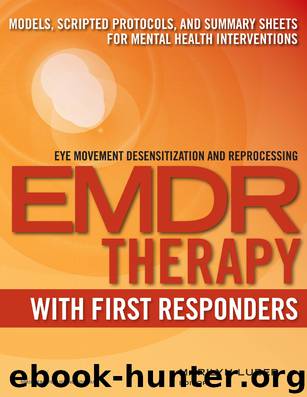EMDR with First Responders by Luber Marilyn;

Author:Luber, Marilyn;
Language: eng
Format: epub
Publisher: Springer Publishing Company
Acute Depression and Suicidality
Reasons for military personnel to develop depression include homesickness from prolonged separation, feeling overwhelmed from painful war experiences or losses, feelings of guilt for actions taken (e.g., killing) or not taken, recent Permanent Change of Station (PCS) transfer and separation from combat support, individual mobilization augmentees separating from their combat support group to return to their home duty station, feeling disconnected from others, sleep deprivation, interpersonal troubles at home or work, and so forth. Suicidal behavior is best assessed with the following criteria: presence of active depression or psychosis, presence of substance abuse, past history of suicidal acts, formulation of plan, a stated intent to carry out the plan, feeling that the world would be better off if the patient were dead, availability of means for suicide (e.g., firearms or pills), disruption of an important personal relationship, and failure at an important personal endeavor.
Acute Post-Traumatic Anger, Aggression, and Violence
In the warzone, or other threatening environments, anger and hyperarousal can be an adaptive human stress response or “survival mode.” Conversely, when unregulated, anger and aggression can reflect a central core maladaptive reaction to trauma resulting in uncontrolled expressions that can be harmful to the service member and those they confront. Anger can range from mild annoyance to rage associated with domestic violence and abuse, road rage, and workplace violence, even if there is no intent to cause harm to others. It is important to distinguish between anger and aggression. Aggression is behavior that is intended to cause harm to another person or damage property. This behavior can include verbal abuse, threats, or violent acts. Anger, on the other hand, is an emotion and does not necessarily lead to aggression. Therefore, a person can become angry without acting aggressively.
Acute Stress Injury in the Medically Wounded
There is a high comorbidity of war stress injury for those wounded in action (WIA). However, it is not unusual for the medical needs of physically wounded clients to be well managed, while mental health aspects go undetected and untreated. Therapists should routinely screen clients who have deployed for WIA status, including being awarded a Purple Heart. For example, Grieger et al. (2006) found that the rates of depression and PTSD among severely wounded American service members increased significantly between the initial 1-month post-injury assessment (where 4.2% had PTSD symptoms and 4.4% had depression) to seven months post-injury (where 12.0% had PTSD and 9.3% met criteria for depression).
In every war a certain number of battle wounds are “self-inflicted,” whether to avoid combat, commit suicide, get a medal, or some other reason—it happens. As of September 2010, a total of 260 deployed military personnel died by self-inflicted wounds. Clients whose wounds are self-induced often carry a burdensome secret and fear eventual discovery.
Acute Medically Unexplained Symptoms (MUPS) and Pain
The DoD’s Post-Deployment Health Assessment and Re-Assessments (PDHA/RA) surveys can provide a potential baseline measure of physical complaints originating during or after deployment, that may eventually be categorized as “medically unexplained” or symptoms, signs, and ill-defined conditions (SSID-VA system).
Download
This site does not store any files on its server. We only index and link to content provided by other sites. Please contact the content providers to delete copyright contents if any and email us, we'll remove relevant links or contents immediately.
Rewire Your Anxious Brain by Catherine M. Pittman(18292)
Talking to Strangers by Malcolm Gladwell(12867)
The Art of Thinking Clearly by Rolf Dobelli(9909)
Mindhunter: Inside the FBI's Elite Serial Crime Unit by John E. Douglas & Mark Olshaker(8699)
Becoming Supernatural by Dr. Joe Dispenza(7832)
Change Your Questions, Change Your Life by Marilee Adams(7371)
The Road Less Traveled by M. Scott Peck(7278)
Nudge - Improving Decisions about Health, Wealth, and Happiness by Thaler Sunstein(7242)
The Lost Art of Listening by Michael P. Nichols(7159)
Mastermind: How to Think Like Sherlock Holmes by Maria Konnikova(6936)
Enlightenment Now: The Case for Reason, Science, Humanism, and Progress by Steven Pinker(6871)
Win Bigly by Scott Adams(6826)
The Way of Zen by Alan W. Watts(6288)
Daring Greatly by Brene Brown(6222)
Big Magic: Creative Living Beyond Fear by Elizabeth Gilbert(5351)
Grit by Angela Duckworth(5295)
Men In Love by Nancy Friday(4963)
Ego Is the Enemy by Ryan Holiday(4956)
Altered Sensations by David Pantalony(4864)
